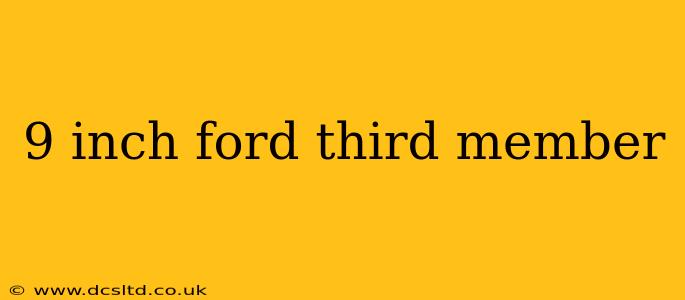Decoding the 9-Inch Ford Third Member: A Deep Dive for Enthusiasts
The Ford 9-inch differential, often referred to as the "9-inch third member," is legendary among car enthusiasts, particularly those involved in hot rodding, muscle car restoration, and off-roading. Its robust design, readily available parts, and impressive strength have cemented its place as a favorite for high-performance applications. This comprehensive guide delves into the intricacies of the 9-inch Ford third member, exploring its history, variations, and what makes it so desirable.
What is a Ford 9-Inch Third Member?
The "third member" is simply a colloquial term referring to the entire differential assembly, which includes the differential case, ring gear, pinion gear, axles, and related components. In the context of the Ford 9-inch, this robust assembly is what makes it such a popular choice for upgrades and modifications. Its large size and durable construction allow it to handle significant torque and horsepower, making it ideal for high-performance vehicles.
Why is the Ford 9-Inch so Popular?
The Ford 9-inch's popularity stems from several key features:
- Strength and Durability: Its robust design can withstand substantial stress, making it suitable for high-horsepower engines and demanding driving conditions. This inherent strength is a major factor in its longevity and widespread adoption in performance applications.
- Parts Availability: Decades of use have created a vast aftermarket support network. Finding replacement parts, upgrades, and customization options is relatively easy and cost-effective compared to other differential types.
- Upgradability: The 9-inch is highly modifiable. Enthusiasts can easily upgrade components like axles, gears, and carriers to tailor the differential to their specific needs and performance goals. This adaptability is a significant contributing factor to its enduring appeal.
- Versatility: The 9-inch has been used in a wide variety of Ford vehicles over the years, making it adaptable to numerous applications. Its relatively straightforward installation process further adds to its versatility.
What are the Different Types of 9-Inch Ford Third Members?
The 9-inch differential wasn't a static design. Over the years, Ford made several modifications resulting in variations in features such as:
- Housing Material: Early versions used nodular iron, while later models might incorporate steel. These differences impact overall strength and weight.
- Axle Shaft Diameter: The diameter of the axle shafts varies depending on the application and year of manufacture. Larger diameter shafts naturally handle greater loads.
- Gear Ratio: Different gear ratios are available to suit different performance needs. Choosing the right gear ratio is crucial for optimizing acceleration and top speed.
- Locker Type: The type of differential locker (e.g., limited-slip, Detroit locker, spool) significantly influences traction and handling characteristics.
How Much Does a 9-Inch Ford Third Member Cost?
The price of a 9-inch third member varies greatly depending on condition, modifications, and whether it's a new or used unit. A used, stock unit can be relatively inexpensive, while a professionally built, high-performance unit with custom modifications can be significantly more expensive. The cost of associated parts and installation labor should also be considered.
Where Can I Find a 9-Inch Ford Third Member?
Used 9-inch third members are readily available from various sources, including salvage yards, online marketplaces (like eBay), and specialty parts suppliers. New units and aftermarket parts are also widely available from performance parts retailers.
What are the Common Problems with a 9-Inch Ford Third Member?
While renowned for durability, even a 9-inch can experience issues. Common problems include:
- Bearing Wear: Like any mechanical component, bearings eventually wear out, leading to noise, vibration, and potential failure.
- Seal Leaks: Leaks can occur at the pinion seal or axle seals, resulting in fluid loss.
- Gear Wear: Excessive wear on the ring and pinion gears can lead to noise, vibration, and reduced performance.
By understanding the nuances of the Ford 9-inch third member, enthusiasts can make informed decisions regarding selection, upgrades, and maintenance, ensuring years of reliable performance. The legendary status of this differential is a testament to its enduring strength and adaptability within the automotive world.
